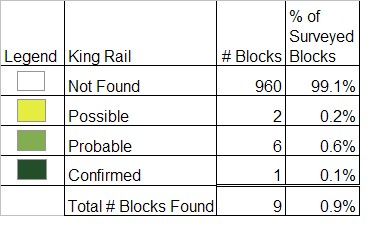Breeding Bird Atlases (BBA)
Find a Bird - BBA1
Breeding Bird Atlas 1 Species Accounts
King Rail
Rallus elegans
State Status
Threatened
Egg Dates
not available
Number of Broods
one; may re-lay if first attempt fails.

Undoubtedly one of the Commonwealth’s least known and rarest breeding species, the King Rail was only once confirmed as a breeder in the state during the Atlas project, and to date its nest has never been discovered in Massachusetts. The species has been a presumed breeder since about 1880, when a brood of young was hand-caught in Sandwich. Since that time, several additional sightings of adults with young have occurred, all in eastern Massachusetts, including the fortuitous encounter of an adult crossing a Middleboro roadway with nine chicks on July 17, 1976.
Because the King Rail is at the northeastern limit of its range in Massachusetts, its historic status has been poorly defined. Records would suggest that the species prefers the same extensive freshwater cattail marshes that are occupied by the more familiar Virginia Rail; however, in southeastern Massachusetts there is also a modest scattering of records from grassy river meadows and from marshes with a moderate shrub cover. Perhaps more significantly, the King Rail has been recorded in summer in the salt marshes of the Parker River National Wildlife Refuge at Plum Island, several times in company with Clapper Rails. The interbreeding of these two species has been the subject of considerable scientific speculation, and some authorities have considered the two forms to be conspecific.
King Rails are typically first heard at presumed breeding meadows in May, although specimen evidence would suggest that some undoubtedly arrive earlier. The species’ local vocalizing is marked by its irregularity, which is totally different from the situation in the southeastern United States and middle Atlantic coastal areas where calling may be heard frequently almost around the clock early in the breeding season. It is possible that in our area, where the species is at the periphery of its breeding range and its density is low, calling may not be as critical to territory maintenance, even in optimal habitats. In any event, the most frequent call in May is a harsh, grating, and accelerating series of notes that may be likened to jupe-jupe-jupe-jupe, etc. This is one of the primary vocalizations of the King Rail, and it seems to correspond to the wak-wak-wak call of the smaller Virginia Rail but is given with much more force and volume. Also heard in Massachusetts from time to time in marshes is a loud, two-part call resembling the phrase, hip-hip-hip, hurraaa, which, it has been suggested, may be given by females seeking their mates or as a contact note given to a distant mate.
In recent years, marshes preferred by King Rails have included Wash Brook on the Wayland-Sudbury line, the large marsh adjacent to Route 128 in Lynnfield, and the freshwater impounded marshes on Plum Island. While local data is lacking, nesting in Massachusetts most likely occurs in June, based upon records from the Middle Atlantic States. Nests, which are constructed by both sexes, are usually located in fairly uniform stands of vegetation and are well concealed, frequently having a cone-shaped or rounded canopy of loosely woven plants overhead. Generally, the nest is on a grassy tussock or amid the stems of some waterside plant. Some nests are actually located over water. Clutches average ten to eleven eggs, which are pale buff in color, sparingly spotted with dark reddish brown. Incubation lasts from 21 to 23 days and is accomplished by both sexes. At hatching, the precocial glossy black chicks immediately abandon the nest, but they stay together with the adults for more than a month.
It is believed that King Rails are the first rails to depart from their breeding grounds in the fall, and the author’s encounters with birds at Monomoy in August, where the species presumably does not nest, would further suggest that possibility. Nonetheless, during the heyday of rail hunting in New England, large numbers of birds were shot right through the fall, including many in salt marshes. There is a surprising legacy of winter records for this species, indicating that at least occasionally the King Rail attempts to winter in our area, almost always along the coast. The regular wintering grounds extend south along the mid-Atlantic coast to Georgia and Florida.
The King Rail is listed as a threatened species in Massachusetts.
Map Legend and Data Summary
Atlas 1 data collected from 1975-1979


Note: rare in freshwater marshes; probably declining
Wayne R. Petersen



